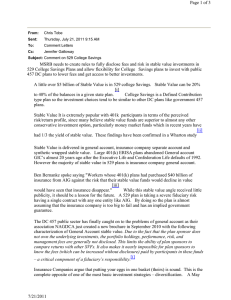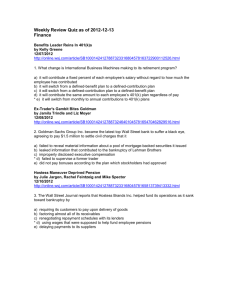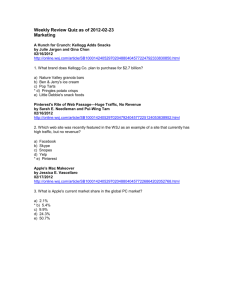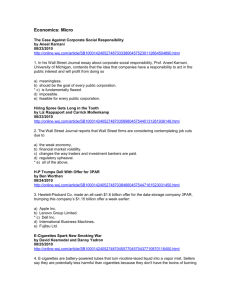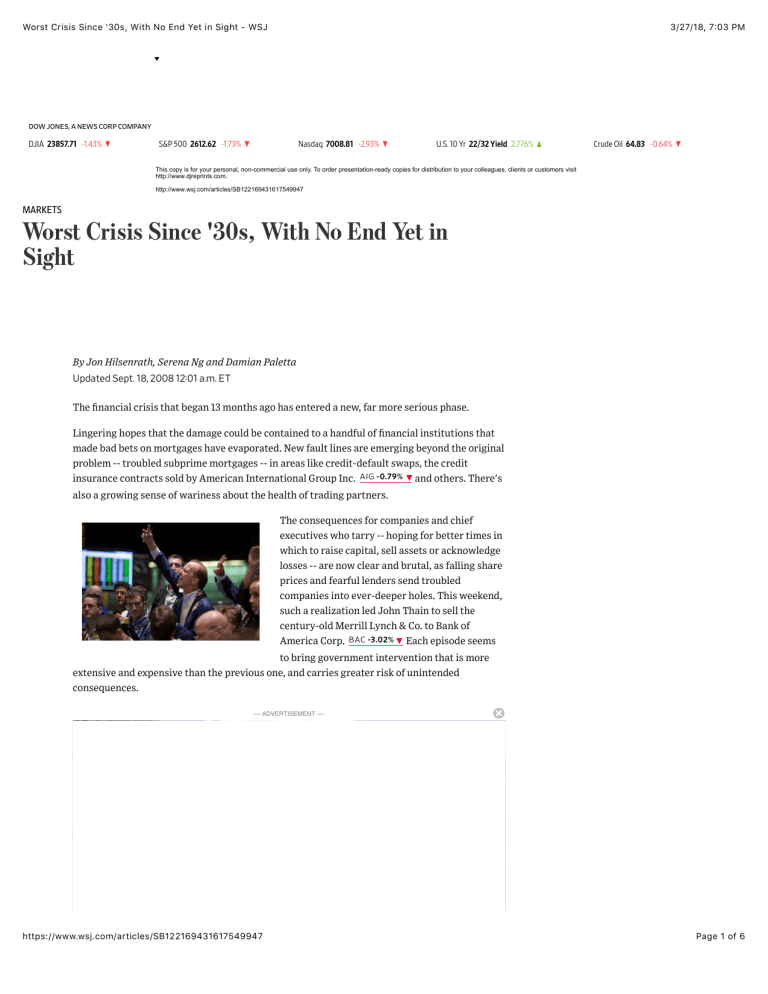
Worst Crisis Since '30s, With No End Yet in Sight - WSJ 3/27/18, 7)03 PM DOW JONES, A NEWS CORP COMPANY DJIA 23857.71 -1.43% ▼ S&P 500 2612.62 -1.73% ▼ Nasdaq 7008.81 -2.93% ▼ U.S. 10 Yr 22/32 Yield 2.776% ▲ Crude Oil 64.83 -0.64% ▼ This copy is for your personal, non-commercial use only. To order presentation-ready copies for distribution to your colleagues, clients or customers visit http://www.djreprints.com. http://www.wsj.com/articles/SB122169431617549947 MARKETS Worst Crisis Since '30s, With No End Yet in Sight By Jon Hilsenrath, Serena Ng and Damian Paletta Updated Sept. 18, 2008 12:01 a.m. ET The financial crisis that began 13 months ago has entered a new, far more serious phase. Lingering hopes that the damage could be contained to a handful of financial institutions that made bad bets on mortgages have evaporated. New fault lines are emerging beyond the original problem -- troubled subprime mortgages -- in areas like credit-default swaps, the credit insurance contracts sold by American International Group Inc. AIG -0.79% and others. There's ▲ also a growing sense of wariness about the health of trading partners. The consequences for companies and chief executives who tarry -- hoping for better times in which to raise capital, sell assets or acknowledge losses -- are now clear and brutal, as falling share prices and fearful lenders send troubled companies into ever-deeper holes. This weekend, such a realization led John Thain to sell the century-old Merrill Lynch & Co. to Bank of America Corp. BAC -3.02% Each episode seems ▲ to bring government intervention that is more extensive and expensive than the previous one, and carries greater risk of unintended consequences. –– ADVERTISEMENT –– https://www.wsj.com/articles/SB122169431617549947 Page 1 of 6 Worst Crisis Since '30s, With No End Yet in Sight - WSJ 3/27/18, 7)03 PM Expectations for a quick end to the crisis are fading fast. "I think it's going to last a lot longer than perhaps we would have anticipated," Anne Mulcahy, chief executive of Xerox Corp. XRX -1.36% , said Wednesday. ▲ "This has been the worst financial crisis since the Great Depression. There is no question about it," said Mark Gertler, a New York University economist who worked with fellow academic Ben Bernanke, now the Federal Reserve chairman, to explain how financial turmoil can infect the overall economy. "But at the same time we have the policy mechanisms in place fighting it, which is something we didn't have during the Great Depression." Spreading Disease The U.S. financial system resembles a patient in intensive care. The body is trying to fight off a disease that is spreading, and as it does so, the body convulses, settles for a time and then convulses again. The illness seems to be overwhelming the self-healing tendencies of markets. The doctors in charge are resorting to ever-more invasive treatment, and are now experimenting with remedies that have never before been applied. Fed Chairman Bernanke and Treasury Secretary Henry Paulson, walking into a hastily arranged meeting with congressional leaders Tuesday night to brief them on the government's unprecedented rescue of AIG, looked like exhausted surgeons delivering grim news to the family. Fed and Treasury officials have identified the disease. It's called deleveraging, or the unwinding of debt. During the credit boom, financial institutions and American households took on too much debt. Between 2002 and 2006, household borrowing grew at an average annual rate of 11%, far outpacing overall economic growth. Borrowing by financial institutions grew by a 10% annualized rate. Now many of those borrowers can't pay back the loans, a problem that is exacerbated by the collapse in housing prices. They need to reduce their dependence on borrowed money, a painful and drawn-out process that can choke off credit and economic growth. At least three things need to happen to bring the deleveraging process to an end, and they're hard to do at once. Financial institutions and others need to fess up to their mistakes by selling or writing down the value of distressed assets they bought with borrowed money. They need to pay off debt. Finally, they need to rebuild their capital cushions, which have been eroded by losses on those distressed assets. But many of the distressed assets are hard to value and there are few if any buyers. Deleveraging also feeds on itself in a way that can create a downward spiral: Trying to sell assets pushes down the assets' prices, which makes them harder to sell and leads firms to try to sell more assets. That, in turn, suppresses these firms' share prices and makes it harder for them to sell new shares to raise capital. Mr. Bernanke, as an academic, dubbed this self-feeding loop a "financial accelerator." "Many of the CEO types weren't willing...to take these losses, and say, 'I accept the fact that I'm selling these way below fundamental value,'" said Anil Kashyap, a University of Chicago Business School economics professor. "The ones that had the biggest exposure, they've all died." Deleveraging started with securities tied to subprime mortgages, where defaults started rising rapidly in 2006. But the deleveraging process has now spread well beyond, to commercial real estate and auto loans to the short-term commitments on which investment banks rely to fund themselves. In the first quarter, financial-sector borrowing slowed to a 5.1% growth rate, about half of the average from 2002 to 2007. Household borrowing has slowed even more, to a 3.5% https://www.wsj.com/articles/SB122169431617549947 Page 2 of 6 Worst Crisis Since '30s, With No End Yet in Sight - WSJ 3/27/18, 7)03 PM pace. Not Enough ▲ Goldman Sachs Group Inc. GS -2.99% economist Jan Hatzius estimates that in the past year, financial institutions around the world have already written down $408 billion worth of assets and raised $367 billion worth of capital. But that doesn't appear to be enough. Every time financial firms and investors suggest that they've written assets down enough and raised enough new capital, a new wave of selling triggers a reevaluation, propelling the crisis into new territory. Residential mortgage losses alone could hit $636 billion by 2012, Goldman estimates, triggering widespread retrenchment in bank lending. That could shave 1.8 percentage points a year off economic growth in 2008 and 2009 -- the equivalent of $250 billion in lost goods and services each year. "This is a deleveraging like nothing we've ever seen before," said Robert Glauber, now a professor of Harvard's government and law schools who came to Washington in 1989 to help organize the savings and loan cleanup of the early 1990s. "The S&L losses to the government were small compared to this." Hedge funds could be among the next problem areas. Many rely on borrowed money to amplify their returns. With banks under pressure, many hedge funds are less able to borrow this money now, pressuring returns. Meanwhile, there are growing indications that fewer investors are shifting into hedge funds while others are pulling out. Fund investors are dealing with their own problems: Many have taken out loans to make their investments and are finding it more difficult now to borrow. That all makes it likely that more hedge funds will shutter in the months ahead, forcing them to sell their investments, further weighing on the market. Debt-driven financial traumas have a long history, from the Great Depression to the S&L crisis to the Asian financial crisis of the late 1990s. Neither economists nor policymakers have easy solutions. Cutting interest rates and writing stimulus checks to families can help -- and may have prevented or delayed a deep recession. But, at least in this instance, they don't suffice. In such circumstances, governments almost invariably experiment with solutions with varying degrees of success. President Franklin Delano Roosevelt unleashed an alphabet soup of new agencies and a host of new regulations in the aftermath of the market crash of 1929. In the 1990s, Japan embarked on a decade of often-wasteful government spending to counter the aftereffects of a bursting bubble. President George H.W. Bush and Congress created the Resolution Trust Corp. to take and sell the assets of failed thrifts. Hong Kong's free-market government went on a massive stock-buying spree in 1998, buying up shares of every company listed in the benchmark Hang Seng index. It ended up packaging them into an exchange-traded fund and making money. Taking Out the Playbook Today, Mr. Bernanke is taking out his playbook, said NYU economist Mr. Gertler, "and rewriting it as we go." Merrill Lynch & Co.'s emergency sale to Bank of America Corp. last weekend was an example of https://www.wsj.com/articles/SB122169431617549947 Page 3 of 6 Worst Crisis Since '30s, With No End Yet in Sight - WSJ 3/27/18, 7)03 PM the perniciousness and unpredictability of deleveraging. In the past year, Merrill had hired a new chief executive, written off $41.4 billion in assets and raised $21 billion in equity capital. But Merrill couldn't keep up. The more it raised, the more it was forced to write off. When Merrill CEO John Thain attended a meeting with the New York Fed and other Wall Street executives last week, he saw that Merrill was the next most vulnerable brokerage firm. "We watched Bear and Lehman. We knew we could be next," said one Merrill executive. Fearful that its lenders would shut the firm off, he sold to Bank of America. Traders on the floor of the New York Stock Exchange Wednesday. Expectations for a quick end to the crisis are fading fast. GETTY IMAGES This crisis is complicated by innovative financial instruments that Wall Street created and distributed. They're making it harder for officials and Wall Street executives to know where the next set of risks is hiding and also contributing to the crisis's spreading impact. Swaps Game The latest trouble spot is an area called credit-default swaps, which are private contracts that let firms trade bets on whether a borrower is going to default. When a default occurs, one party pays off the other. The value of the swaps rise and fall as the market reassesses the risk that a company won't be able to honor its obligations. Firms use these instruments both as insurance -- to hedge their exposures to risk -- and to wager on the health of other companies. There are now credit-default swaps on more than $62 trillion in debt, up from about $144 billion a decade ago. One of the big new players in the swaps game was AIG, the world's largest insurer and a major seller of credit-default swaps to financial institutions and companies. When the credit markets were booming, many firms bought these instruments from AIG, believing the insurance giant's strong credit ratings and large balance sheet could provide a shield against bond and loan defaults. AIG believed the risk of default was low on many securities it insured. As of June 30, an AIG unit had written credit-default swaps on more than $446 billion in credit assets, including mortgage securities, corporate loans and complex structured products. Last year, when rising subprime-mortgage delinquencies damaged the value of many securities AIG had insured, the firm was forced to book large write-downs on its derivative positions. That spooked investors, who reacted by dumping its shares, making it harder for AIG to raise the capital it increasingly needed. MORE ON THE CRISIS Mounting Fears Shake World Markets Morgan Stanley in Talks With Wachovia Unheard Pleas, Lost Chances for AIG Complete Coverage: Wall Street in Crisis Credit default swaps "didn't cause the problem, but they certainly exacerbated the financial crisis," said Leslie Rahl, president of Capital Market Risk Advisors, a consulting firm in New York. The sheer volume of CDS contracts outstanding -- and the fact that they trade directly between institutions, without centralized clearing -- intertwined the fates of many large banks and brokerages. https://www.wsj.com/articles/SB122169431617549947 Page 4 of 6 Worst Crisis Since '30s, With No End Yet in Sight - WSJ 3/27/18, 7)03 PM Few financial crises have been sorted out in modern times without massive government intervention. Increasingly, officials are coming to the conclusion that even more might be needed. A big problem: The Fed can and has provided short-term money to sound, but struggling, institutions that are out of favor. It can, and has, reduced the interest rates it influences to attempt to reduce borrowing costs through the economy and encourage investment and spending. But it is ill-equipped to provide the capital that financial institutions now desperately need to shore up their finances and expand lending. Resolution Trust Scenario In normal times, capital-starved companies usually can raise money on their own. In the current crisis, a number of big Wall Street firms, including Citigroup Inc., C -2.15% have turned ▲ to sovereign-wealth funds, the government-controlled pools of money. But both on Wall Street and in Washington, there is increasing expectation that U.S. taxpayers will either take the bad assets off the hands of financial institutions so they can raise capital, or put taxpayer capital into the companies, as the Treasury has agreed to do with mortgage giants Fannie Mae and Freddie Mac. One proposal was raised by Barney Frank, the Massachusetts Democrat who is chairman of the House Financial Services Committee. Rep. Frank is looking at whether to create an analog to the Resolution Trust Corp., which took assets from failed banks and thrifts and found buyers over several years. "When you have a big loss in the marketplace, there are only three people that can take the loss -- the bondholders, the shareholders and the government," said William Seidman, who led the RTC from 1989 to 1991. "That's the dance we're seeing right now. Are we going to shove this loss into the hands of the taxpayers?" The RTC seemed controversial and ambitious at the time. Any version today would be even more complex. The RTC dispensed mostly of commercial real estate. Today's troubled assets are complex debt securities -- many of which include pieces of other instruments, which in turn include pieces of others, many steps removed from the actual mortgages or consumer loans on which they are based. Unraveling these strands will be tedious and getting at the underlying collateral, difficult. In the early stages of this crisis, regulators saw that their rules didn't fit the rapidly changing financial system they were asked to oversee. Investment banks, at the core of the crisis, weren't as closely monitored by the Securities and Exchange Commission as commercial banks were by their regulators. The government has a system to close failed banks, created after the Great Depression in part to avoid sudden runs by depositors. Now, runs happen in spheres regulators may not fully understand, such as the repurchase agreement, or repo, market, in which investment banks fund their day-to-day operations. And regulators have no process for handling the failure of an investment bank like Lehman Brothers Holdings Inc. Insurers like AIG aren't even federally regulated. Regulators have all but promised that more banks will fail in the coming months. The Federal Deposit Insurance Corp. is drawing up a plan to raise the premiums it charges banks so that it can rebuild the fund it uses to back deposits. Examiners are tightening their leash on banks across the country. Pleasant Mystery One pleasant mystery is why the crisis hasn't hit the economy harder -- at least so far. "This financial crisis hasn't yet translated into fewer...companies starting up, less research and development, less marketing," Ivan Seidenberg, chief executive of Verizon Communications, said Wednesday. "We haven't seen that yet. I'm sure every company is keeping their eyes on it." https://www.wsj.com/articles/SB122169431617549947 Page 5 of 6 Worst Crisis Since '30s, With No End Yet in Sight - WSJ 3/27/18, 7)03 PM At 6.1%, the unemployment rate remains well below the peak of 7.8% in 1992, amid the S&L crisis. In part, that's because government has reacted aggressively. The Fed's classic mistake that led to the Great Depression was that it tightened monetary policy when it should have eased. Mr. Bernanke didn't repeat that error. And Congress moved more swiftly to approve fiscal stimulus than most Washington veterans thought possible. In part, the broader economy has held mostly steady because exports have been so strong at just the right moment, a reminder of the global economy's importance to the U.S. And in part, it's because the U.S. economy is demonstrating impressive resilience, as information technology allows executives to react more quickly to emerging problems and -- to the discomfort of workers -- companies are quicker to adjust wages, hiring and work hours when the economy softens. But the risk remains that Wall Street's woes will spread to Main Street, as credit tightens for consumers and business. Already, U.S. auto makers have been forced to tighten the terms on their leasing programs, or abandon writing leases themselves altogether, because of problems in their finance units. Goldman Sachs economists' optimistic scenario is a couple years of mild recession or painfully slow economy growth. —Aaron Lucchetti, Mark Whitehouse, Gregory Zuckerman and Sudeep Reddy contributed to this article. Write to Jon Hilsenrath at jon.hilsenrath@wsj.com, Serena Ng at serena.ng@wsj.com and Damian Paletta at damian.paletta@wsj.com Copyright ©2017 Dow Jones & Company, Inc. All Rights Reserved This copy is for your personal, non-commercial use only. To order presentation-ready copies for distribution to your colleagues, clients or customers visit http://www.djreprints.com. https://www.wsj.com/articles/SB122169431617549947 Page 6 of 6
